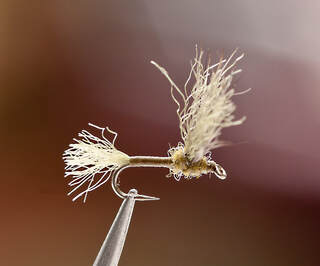Fly of the Month
Our second article for 2015 is in two parts, Blue Wing Olive (BWO). Part One will cover the adult stage and Part Two will cover the nymph stage. Recall… “This “fly of the month” represents the latest in the Tim Wilhelm/Tom Adams series, Blue-winged Olives. Positively rheotactic!” says Tim Wilhelm in his article in October 2011.
Well, Tom and I decided to revisit the BWO and provide even more depth and understanding. A primary reason is the success of winter fly fishing on Delayed-Harvest streams too often depends on BWO fly patterns due to the weather. Hold over hatchery raised trout learn quickly that a huge food source on our North Carolina streams are BWOs. With three distinct species available, there is typically a BWO hatch on any given day that is cloudy, overcast, drizzly or even during intermittent rain, especially early in the morning and later in the afternoon. Yes, cloudy rainy days so do not give up and go home on such a dreary day, rather stay a while and try BWO fly patterns.
Blue Wing Olive – Part One – Adults
Blue Winged Olives are typically small flies that hatch in great numbers. They produce up to three broods or generations annually. BWOs are rarely larger than 16 and usually smaller than 18. In the past, BWOs were not very important to most anglers only fly fishing during the warmer spring and fall seasons. Changes in fishing seasons which allow the angler to fish all winter long have made BWOs increasingly important. Terry Hill recently shared his latest adventure on the South Holston River. He encountered one of the thickest BWO hatches he has ever fly fished in on New Year Day 2015!
There are several species of BWOs in the family Baetidae including B. devinctus, B. pygmaeus and B. vagans which are present in most streams in North Carolina. There is also a Fallceon family species, F. quilleri that thrives in streams throughout North America. Having a Latin name pygmaeus or “pigmy” tells you right off that these insects are small, well even tiny! Enough taxonomy, to summarize, the various species and many broods annually of each species assure that BWOs are present in numbers in our streams.
Recall “BWOs are small, the surface of smooth water is a barrier to them, and many are trapped just below the surface or must struggle to break through the water’s surface tension so emerging patterns work well. Both emergers and dry flies worked in slow runs and back eddies will raise fish but don’t forget to fish the foam lines!” says Tim Wilhelm in his article in October 2011.
We will cover emergers below the surface in part two; however, the surface may well have both cripples due to the surface struggle and due to harsh weather conditions as well as a pronounced male spinner fall in the afternoon on days when the weather clears. Recall “…the egg-laying female crawls below the surface to lay eggs…” says Tim Wilhelm in his article in October 2011.
Due to the small sizes is difficult to determine which BWO situation you are encountering Maybe the emerged duns are floating longer on the surface before taking flight which may require the traditional dry fly or a comparadun which floats lower in the surface film. More likely in the morning hours the BWOs on the surface are struggling to take flight and a BWO cripple may be required. In the afternoon hours a BWO spinner can be most effective. Yes, this is advice is applicable on our Delayed-Harvest streams just as much as it is on the South Holston tailrace during the winter months. We provide three (3) additional recipes for dry fly presentations of the Blue Wing Olive. Note, the comparadun recipe and the sparkle dun recipe are the same except for the tail. The comparadun has a split tail and the sparkle dun has a “shuck tail” representing a hatched BWO struggling to escape from the shuck.
Improved Sparkle Dun BWO
HOOK : Dry Fly, Tiemco 100 or equivalent, size : 14,16,18,20,22,24
Thread : Uni-thread Olive Dun 8/0
Tail/Shuck: Zelon.
Abdomen: Olive Dun tying thread or BWO Goose biot or Olive dubbing
Thorax: Olive dubbing
Wing: Zelon and Comparadun deer dyed dun
This is a simple and extremely effective pattern from Mike Lawson at Blue Ribbon Flies. Easy to tie, even in small sizes ( necessary for BWO) this improved version has one small modification with the zelon that makes it float higher and longer and also makes it more visible. That is very important on small flies.
Blue Wing Olive (BWO) Comparadun
Blue Wing Olive (BWO) Spinner
- Tom Adams, Alen Baker
Our second article for 2015 is in two parts, Blue Wing Olive (BWO). Part One will cover the adult stage and Part Two will cover the nymph stage. Recall… “This “fly of the month” represents the latest in the Tim Wilhelm/Tom Adams series, Blue-winged Olives. Positively rheotactic!” says Tim Wilhelm in his article in October 2011.
Well, Tom and I decided to revisit the BWO and provide even more depth and understanding. A primary reason is the success of winter fly fishing on Delayed-Harvest streams too often depends on BWO fly patterns due to the weather. Hold over hatchery raised trout learn quickly that a huge food source on our North Carolina streams are BWOs. With three distinct species available, there is typically a BWO hatch on any given day that is cloudy, overcast, drizzly or even during intermittent rain, especially early in the morning and later in the afternoon. Yes, cloudy rainy days so do not give up and go home on such a dreary day, rather stay a while and try BWO fly patterns.
Blue Wing Olive – Part One – Adults
Blue Winged Olives are typically small flies that hatch in great numbers. They produce up to three broods or generations annually. BWOs are rarely larger than 16 and usually smaller than 18. In the past, BWOs were not very important to most anglers only fly fishing during the warmer spring and fall seasons. Changes in fishing seasons which allow the angler to fish all winter long have made BWOs increasingly important. Terry Hill recently shared his latest adventure on the South Holston River. He encountered one of the thickest BWO hatches he has ever fly fished in on New Year Day 2015!
There are several species of BWOs in the family Baetidae including B. devinctus, B. pygmaeus and B. vagans which are present in most streams in North Carolina. There is also a Fallceon family species, F. quilleri that thrives in streams throughout North America. Having a Latin name pygmaeus or “pigmy” tells you right off that these insects are small, well even tiny! Enough taxonomy, to summarize, the various species and many broods annually of each species assure that BWOs are present in numbers in our streams.
Recall “BWOs are small, the surface of smooth water is a barrier to them, and many are trapped just below the surface or must struggle to break through the water’s surface tension so emerging patterns work well. Both emergers and dry flies worked in slow runs and back eddies will raise fish but don’t forget to fish the foam lines!” says Tim Wilhelm in his article in October 2011.
We will cover emergers below the surface in part two; however, the surface may well have both cripples due to the surface struggle and due to harsh weather conditions as well as a pronounced male spinner fall in the afternoon on days when the weather clears. Recall “…the egg-laying female crawls below the surface to lay eggs…” says Tim Wilhelm in his article in October 2011.
Due to the small sizes is difficult to determine which BWO situation you are encountering Maybe the emerged duns are floating longer on the surface before taking flight which may require the traditional dry fly or a comparadun which floats lower in the surface film. More likely in the morning hours the BWOs on the surface are struggling to take flight and a BWO cripple may be required. In the afternoon hours a BWO spinner can be most effective. Yes, this is advice is applicable on our Delayed-Harvest streams just as much as it is on the South Holston tailrace during the winter months. We provide three (3) additional recipes for dry fly presentations of the Blue Wing Olive. Note, the comparadun recipe and the sparkle dun recipe are the same except for the tail. The comparadun has a split tail and the sparkle dun has a “shuck tail” representing a hatched BWO struggling to escape from the shuck.
Improved Sparkle Dun BWO
HOOK : Dry Fly, Tiemco 100 or equivalent, size : 14,16,18,20,22,24
Thread : Uni-thread Olive Dun 8/0
Tail/Shuck: Zelon.
Abdomen: Olive Dun tying thread or BWO Goose biot or Olive dubbing
Thorax: Olive dubbing
Wing: Zelon and Comparadun deer dyed dun
This is a simple and extremely effective pattern from Mike Lawson at Blue Ribbon Flies. Easy to tie, even in small sizes ( necessary for BWO) this improved version has one small modification with the zelon that makes it float higher and longer and also makes it more visible. That is very important on small flies.
- Mount debarbed hook in vise. Note: Most flies benefit from as few as possible thread wraps and smooth flat turns. To accomplish this using the smallest thread size that is practical is the first step. In addition, most threads will flatten by rotating in a counter clockwise fashion. Tie in, extend the thread to a length that will allow the bobbin to hang without touching the counter. Spin counterclockwise and you will see the thread widen and flatten. This is virtually a standard practice in tying all flies. You will also need to continue to spin as you wrap, because the act of wrapping put turns back in. Tie thread on, starting two eyelengths from eye and advance in tight touching turns to above the hook barb. Return the hook in tight touching turns to the tie in point and let the bobbin hang.
- Select a small clump of deer hair, trim from hide and clean away the underfur. Stack and tie in at the one third mark on top of the hook shank. Be careful not to spin or let the hair rotate on the hook. The length is about the same as the hook shank, Secure the deer by tying toward the hook bend. Do not worry about standing the hair at this time. Let the bobbin hang at the one third mark.
- Select a hank of zelon, square cut one end, to even the tips. Tie in at the same spot as the deer and leave the square cut end even with the tips of the deer hair. Continue to tie in the zelon moving in tight, touching turns to the hook bend, stopping above the barb. Trim the zelon to slightly less than the length of the hook shank.
- Advance the thread in tight, touching turns to the deer hair. Lift a section of zelon and deer and holding up and slightly back make one or two turns of thread. Repeat going forward until all the deer/zelon are upright and secure. Let the bobbin hang.
- Select BWO dry fly, fine dubbing and form a small noodle. Wrap the dub around the wing in a figure eight finishing in front of the wing.
- Whip finish.
Blue Wing Olive (BWO) Comparadun
Blue Wing Olive (BWO) Spinner
- Tom Adams, Alen Baker

